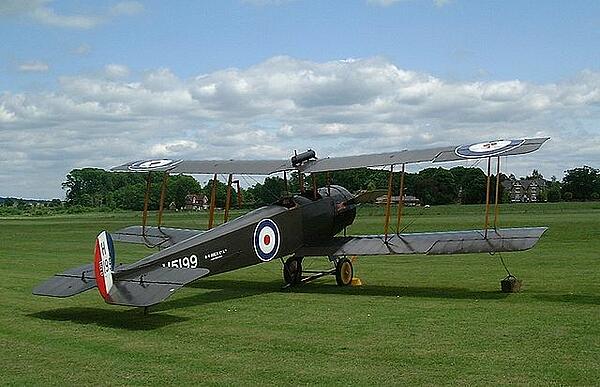Avro 504
The Avro 504 was designed by Alliot Verdon Roe and was a British trainer aircraft for World War One - although a few saw service in the Second World War, too. During the First World War, there were more Avro 504s built that another other British air fact and it was the most commonly used aircraft during training for the Royal Flying Corps (RFC).
Roe had entered World War One with a desire to help mould a British aviation industry that designed British aircraft using British designers and created these craft with British engineers. Despite being just a few years since the first manned flight, Roe managed to find financial backing and in 1907 he became the first British pilot to fly an all-British powered aircraft - the Roe II Tri-plane. Unfortunately, his achievement was somewhat overshadowed when Louis Blérot flew across the English Channel just ten days later - in July 1907. However, Blérot’s success did help to boost the interest in the aviation industry, indirectly leading to more interest and financial backing for Roe.
Roe created both bi-planes and tai-planes, and it was his two-seater E500 that eventually landed him an order from the War Office. Between 1912 and 1913, 12 dual-controlled E500 trainers were ordered, and this injection of cast made it possible for Toe to set up A V Roe and Co Ltd.
The 504 was the natural development from the E500 and work began on it in April 1913. Twelve weeks later, a prototype was flying at Brooklands and by September 1914 it reached a speed of 66mph in an aerial race, eventually coming fourth in the Second Aerial Derby.

As the war drew closer, the War Office ordered 12 Avro 504s and the Admiralty ordered one, with all 13 delivered in September 1914. The RFC did not immediately take to the new plane but in November 1914 they were used as part of a bombing raid on Zeppelin sheds at Friedrichshafen.
Roe continued to develop the plane, and in early 1915 the 504A was introduced. This became the main version of the plane that was produced for the next two years. While similar to its predecessor, it had shorter but broader ailerons to allow better control and some had no canvas cover over the lower wing to increase visibility.
The 504B reverted to the old style of ailerons but it had a larger rudder, which was thought to make the planes even more responsive. There were 240 504Bs built, the majority of which were used for training but two were fitted with machine guns - including upward firing Lewis machine guns - and were based in Dunkirk.
The Avro 504 continued to be developed and the first mass produced version was the J. This version had a 100 hp Gnome Monosoupape engine and was the first to use the Gosport speaking tube to allow pilots to communicate with the trainer. There were 1,050 504 Js built in total.
Arguably the most famous 504 was the Avro 504K, which had a new form of engine mounting system that allowed the standardisation of the airframe around an open-fronted cowling. As a result, 6,350 were made, with 100 being produced a week. The Americans were so impressed with it that they also ordered 52 for use by the American Expeditionary Force.
By the end of the war, more 504s had been built that any other aircraft in the world, with 8,340 officially being built by Avro or sub-contractors. Due to the vast majority never seeing combat, many survived the war and were sold off in great numbers by the RAF.
A 504K without an engine could cost as little as £868 from the Aircraft Disposal Company while a good engine would cost around £907. This meant it was possible to buy an Avro 504 for around £1,800. As such, many foreign governments including Australia, New Zealand, Estonia, Japan and Canada purchased Avro 504s. The fact that the aircraft was two seater also meant many were used in what became known as ‘flying circuses’ during the 1920s and 1930s, while others were used just for pleasure. Percival Philips - captain in the RFC/RAF during the war and recipients of a DFC award - for example flew 91,000 passengers in his 504K over 15 years.
The RAF continued to use the 504 as a training craft after the war and 512 were ordered between 1927 and 1933. They were even used in World War Two, with the original used as Hotspur glider units and the 504N created to develop towing techniques for the airborne forces.
MLA Citation/Reference
"Avro 504". HistoryLearning.com. 2024. Web.
